
Key Takeaways
- A sales cadence is a structured plan that guides sales teams on how and when to communicate with potential customers during the sales process.
- Personalization is key in effective sales, and sales cadences enable tailored approaches by adapting to prospect behaviors and preferences.
- Time management is critical, and sales cadences contribute by optimizing when and how teams reach out to prospects for efficient sales processes.
- Measuring conversion rates, response rates, sales cycle length, deal velocity, customer retention, and sales team feedback ensures an impactful and data-driven sales cadence strategy.
Imagine creating a sales cadence like putting together a friendly conversation with potential customers.
It’s not just a plan; it’s like an art where you must be careful, make it personal, and keep trying.
A good sales cadence is like a song guiding customers through a well-thought-out journey.
This guide will show you 6 examples to make your sales cadence catch attention and practices, best sales cadence software to build meaningful connections.
Each step in the sales cadence is integral to a successful conversation.
What is a sales cadence?

A sales cadence is a structured plan that guides sales teams on how and when to communicate with potential customers during the sales process.
It’s like a roadmap for salespeople, outlining the steps and timing for reaching out to leads through various channels like emails, calls, and social media.
The goal is to build relationships and move leads smoothly through the sales pipeline.
It’s a strategy that helps salespeople know when to talk to customers and what to say, much like following a recipe for successful sales.
Imagine you’re trying to sell a fantastic new product.
A sales cadence would be the recipe that tells you when to send information, make a call, or even connect on social media to showcase the product’s value.
It’s all about creating a smooth and effective journey for turning interested leads into satisfied customers.
Why is sales cadence essential for your business?

1. Efficiency
Sales cadence is vital for efficiency in the sales process.
By defining a clear action plan, teams can strategically target leads, reducing the likelihood of overlooking potential customers.
Efficient use of sales cadences enables teams to prioritize high-value opportunities, making the most of their time and resources.
Utilizing the best sales cadence ensures a streamlined approach, minimizing wasted efforts on unresponsive leads.
For captivating subject lines and content, consider utilizing an AI writer for ideas and an AI humanizer like Stealthly to improve its appeal and readability.
Teams can focus on prospects showing genuine interest, increasing the overall efficiency of the sales cycle.
2. Consistency
Consistency is key in reinforcing brand identity, and sales cadences are pivotal.
A well-structured cadence ensures that each interaction, whether through emails, calls, or other channels, aligns with the established brand message.
This consistency builds trust and recognition, strengthening the overall impact of your sales efforts.
When employing sales cadences in sales, maintaining a consistent approach helps create a unified customer experience.
Prospects receive a cohesive and reliable message, reinforcing your brand’s value proposition and positioning in the market.
3. Personalization
Personalization is a cornerstone of effective sales, and sales cadences enable a tailored approach.
By incorporating personalization into each touchpoint, such as customizing emails based on prospect behavior, teams can create a more engaging and relevant experience.
In the context of cadences in sales, the best sales cadences are those that strike a balance between structure and personalization.
By understanding prospects’ unique needs, sales teams can adapt their cadences to resonate with individual preferences, fostering stronger connections.
4. Time management
Effective time management is critical to successful sales, and cadence sales strategies contribute significantly to this.
By defining the cadence in sales, teams can optimize when and how they reach out to prospects, preventing wasted time on unproductive pursuits.
In the realm of best outbound sales cadence practices, time management becomes even more crucial.
The best sales cadences in an outbound strategy ensure that teams allocate their time efficiently, focusing on channels and approaches that yield the highest response rates and conversions.
5. Relationship building
Sales cadences play a pivotal role in relationship building with potential customers.
By providing a structured and consistent series of interactions, teams can nurture leads through various sales funnel stages, establishing a foundation of trust and rapport.
Relationship building takes on a new dimension in the digital sales cadence landscape.
Leveraging digital channels, teams can maintain consistent communication, adapting their cadences to suit the preferences of modern, digitally oriented customers.
6. Lead nurturing
Cadences in sales are instrumental in lead nurturing.
A well-designed sales cadence guides leads seamlessly from the initial awareness stage to consideration and, ultimately, the decision-making phase.
This nurturing process ensures prospects receive the correct information at the right time, increasing the likelihood of conversion.
The best outbound sales cadences excel in lead nurturing by addressing prospect needs and concerns throughout the cadence.
This strategic approach builds a relationship of trust, positioning your product or service as the ideal solution.
7. Adaptability
The adaptability of a sales cadence is crucial for long-term success.
By regularly analyzing performance metrics and incorporating feedback, teams can refine and adapt their cadences to stay effective in a dynamic market environment.
In the context of best sales cadences, adaptability is a key factor.
The best sales cadences are not static; they evolve based on changing market trends, customer preferences, and the overall effectiveness of the sales strategy.
Sales cadence best practices

In the realm of sales strategy, mastering the art of communication is paramount. Sales cadence, a structured sequence of touchpoints, requires careful navigation.
Understanding and implementing the best 7 practices in sales cadences are essential for crafting effective, personalized, and result-oriented outreach strategies.
1. Segmentation
Segmentation is a crucial component of effective sales cadences.
By categorizing your audience based on industry, size, or specific needs, you tailor your approach to resonate with the unique characteristics of each group.
When applied to sales cadences, this targeted strategy ensures that your outreach is not generic but rather personalized, addressing each segment’s distinct pain points and preferences.
2. Multichannel approach
A multichannel approach in sales cadences involves leveraging various communication channels such as emails, calls, and social media.
This diversity is key to reaching prospects where they are most responsive.
The best sales cadences incorporate multiple channels strategically, optimizing the overall outreach strategy for maximum impact and engagement.
3. Timely follow-ups
Timely follow-ups are a cornerstone of effective sales cadences.
Consistency and persistence in reaching out to prospects through emails or calls showcase dedication.
This continuous engagement keeps your brand at the forefront of prospects’ minds, increasing the chances of conversion in your sales cadence.
4. Continuous optimization
Continuous optimization is a best practice in sales cadences.
Regularly analyzing performance metrics and seeking feedback from the sales team allows for refinement and adaptation.
This iterative approach ensures that your sales cadence remains effective in a dynamic market environment, contributing to long-term success.
5. Personalization
Personalization is a critical element in sales cadences.
Tailoring your approach based on individual prospect behaviors and preferences creates a more meaningful connection.
The best sales cadences prioritize personalized communication, enhancing the overall effectiveness of the outreach and fostering a stronger relationship with prospects.
6. Clear call-to-action
Including a clear call-to-action is essential in each interaction within a sales cadence.
Guiding prospects on the next steps streamlines their journey through the sales funnel and encourages engagement.
The best sales cadences incorporate compelling calls-to-action that prompt prospects to take desired actions.
7. A/B Testing
A/B testing is a valuable practice within sales cadences.
Experimenting with different elements, whether the content of emails, messaging strategies, or timing, helps identify what resonates best with your audience.
The insights gained from A/B testing contribute to refining and optimizing your sales cadence for maximum effectiveness.
Implementing these sales cadence best practices ensures a strategic, engaging, and responsive outreach strategy that adapts to the evolving dynamics of the market and customer behavior.
Whether in the context of digital sales cadences or outbound strategies, these practices contribute to the overall success of your sales efforts.
6 Proven sales cadence examples

Exploring proven sales cadence examples is like uncovering the secret sauce to successful outreach.
Each example offers unique insights into tailoring strategies for specific scenarios, making the sales process more effective and engaging.
Let’s delve into seven noteworthy sales cadence examples, dissecting their nuances and discovering the artistry behind successful B2B and enterprise client engagement.
1. B2B sales cadence
In B2B sales cadences, the emphasis is on a well-orchestrated approach that harmonizes various channels.
This may involve targeted emails, personalized calls, and strategic social media interactions.
The best sales cadences for B2B scenarios consider the unique needs of businesses, offering a systematic engagement strategy that aligns with the complexity and decision-making processes often associated with B2B transactions.
2. Sales cadence for enterprise clients
Crafting a sales cadence for enterprise clients demands a nuanced strategy.
The best sales cadences for enterprise-level engagements are characterized by meticulous research and a deep understanding of the client’s industry and challenges.
Communication is tailored to address the specific concerns and goals of the enterprise, often involving detailed proposals, case studies, and a focus on building a lasting, mutually beneficial relationship.
3. B2B sales cadence for clients who don’t respond after the demo
In scenarios where clients remain unresponsive after a demo, a well-crafted B2B sales cadence comes into play.
The best sales cadences in this context are persistent yet respectful.
They involve targeted follow-ups that acknowledge any concerns raised during the demo and provide additional value, such as success stories or relevant resources.
The aim is to rekindle interest without being intrusive, compellingly showcasing the product’s value.
4. Trial sign-up to conversion sales cadence
Guiding prospects from trial sign-up to conversion requires a strategic sales cadence.
The best sales cadences in this scenario focus on providing seamless onboarding support, highlighting key features, and emphasizing the value proposition.
From acknowledging initial interest to nudging users towards becoming paying customers, the cadence ensures a smooth transition and a compelling journey that underscores the benefits of conversion.
5. Send an email pitching your product/service
The best sales cadences capture attention with compelling subject lines and concise, impactful messaging in a direct email pitch.
These cadences clearly articulate the unique value proposition and include a strong call to action.
The digital sales cadence is often optimized for email effectiveness, leveraging persuasive language and compelling visuals to prompt immediate engagement.
6. Breakup email
The breakup email is a delicate yet effective component of sales cadences, especially for prospects who have gone silent.
The best sales cadences in breakup emails balance empathy and persuasion.
These emails express an understanding of the prospect’s situation, reinforce the value of the offering, and leave the door open for future interactions.
It’s a strategic outreach that respects the prospect’s decision while offering an opportunity for re-engagement.
Exploring these diverse sales cadences reveals the versatility and adaptability required in modern sales strategies.
Whether in B2B engagements, enterprise-level interactions, post-demo follow-ups, conversion journeys, direct pitches, or breakup communications, the best sales cadences align with the scenario’s specific needs and maintain a focus on building meaningful connections.
Best sales cadence software
1. Salesmate
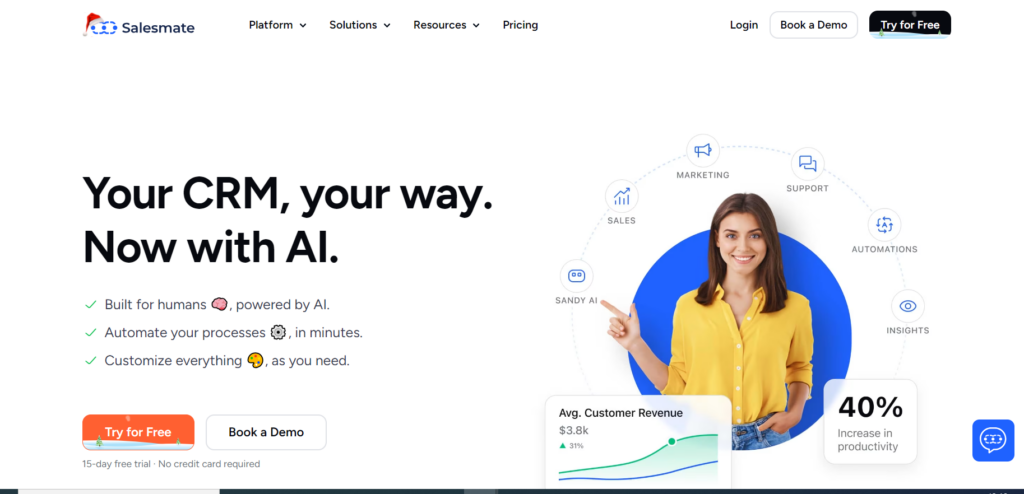
Salesmate stands out as a comprehensive sales cadence solution with its user-friendly interface and powerful automation capabilities.
Catering to businesses of varying sizes, Salesmate excels in streamlining the sales process, enhancing team collaboration, and offering transparent pricing models.
Its intuitive design ensures quick implementation, making it a preferred choice for those seeking efficiency and adaptability in their sales cadences.
Features
- Salesmate’s feature-rich platform includes customizable email templates, facilitating personalized outreach.
- Automated follow-ups ensure consistent communication, and detailed analytics empower data-driven decision-making.
- With seamless CRM integration, Salesmate provides a centralized hub for effective lead management.
- The user-friendly interface enhances the intuitiveness of the sales process, making it accessible and efficient.
Why this is good for your business?
- For businesses aiming for efficiency, Salesmate’s task automation and analytics-driven insights prove invaluable.
- It streamlines CRM processes, ensuring comprehensive lead management.
- The adaptability of Salesmate makes it suitable for businesses of varying sizes, and its collaborative features enhance team efficiency.
2. HubSpot
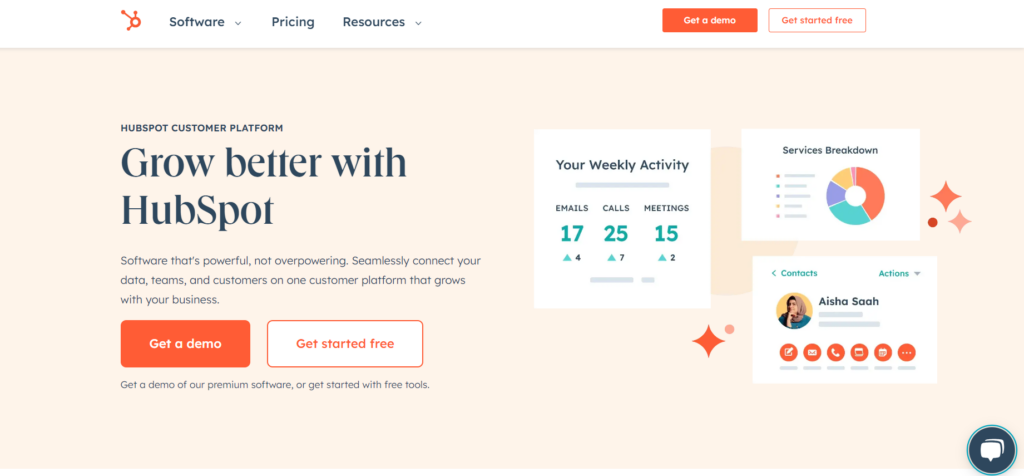
HubSpot’s Sales Hub is renowned for its seamless integration with marketing efforts and customizable CRM features.
Ideal for businesses prioritizing a holistic approach to customer relationship management, HubSpot offers transparency in pricing with various plans to suit different needs.
Its collaborative team features and detailed analytics contribute to enhanced overall efficiency in sales cadences.
Features
- HubSpot’s Sales Hub offers advanced features such as email tracking, personalized outreach, and integration with other HubSpot tools.
- Detailed analytics support data-driven sales strategies, and collaborative team features enhance overall efficiency.
- The customizable CRM ensures tailored customer management for diverse business needs.
Why this is good for your business?
- HubSpot’s all-in-one solution is ideal for businesses seeking seamless integration with marketing efforts.
- Its holistic approach to customer relationship management makes it a preferred choice for those prioritizing alignment between sales and marketing strategies.
- The free option with basic features caters to businesses of varying sizes.
3. QuickMail
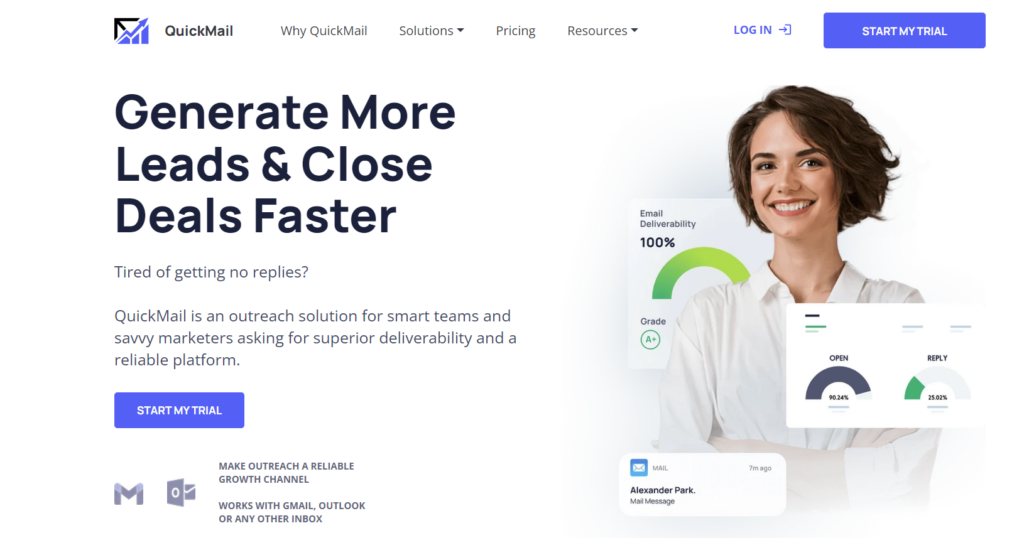
Specializing in outbound email campaigns, QuickMail focuses on effective email sequencing and delivery.
It caters to businesses concentrating on outbound sales cadences and offers user-friendly design for quick implementation.
QuickMail’s transparent pricing models and A/B testing options make it an accessible choice for businesses aiming to improve email engagement and reach.
Features
- QuickMail specializes in outbound email campaigns, offering features like campaign automation, A/B testing, and deliverability tracking.
- Its focused approach ensures effective crafting and optimization of email sequences for outbound sales cadences.
Why this is good for your business?
- Ideal for businesses with a primary focus on outbound sales cadences, QuickMail’s emphasis on email deliverability ensures effective reach.
- Its user-friendly design facilitates quick implementation, and A/B testing contributes to improved email engagement.
4. Close
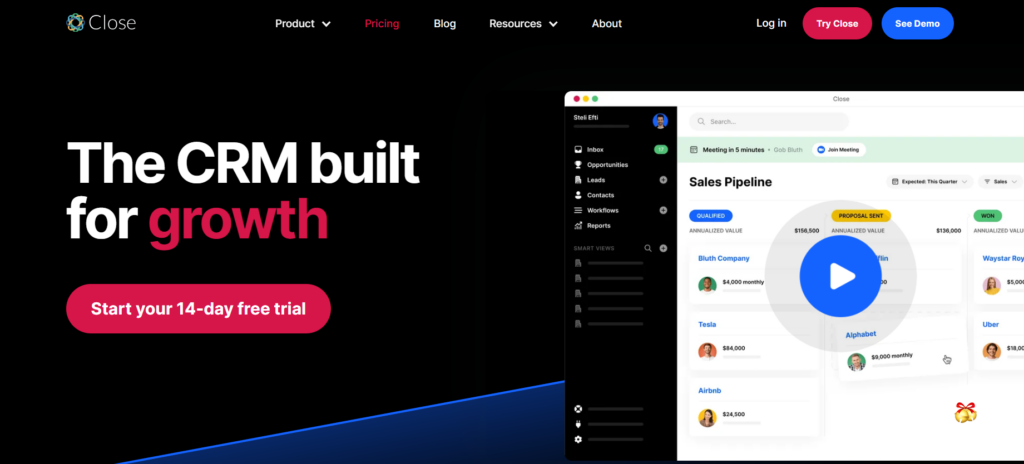
Close is designed to streamline the sales process with its user-friendly interface and emphasis on call automation.
Suited for businesses of varying sizes, Close enhances team collaboration with robust task management features.
Its scalable pricing options and transparent structures, coupled with trial options, contribute to a user-friendly experience for businesses seeking efficiency in sales cadences.
Features
- Close’s features include email automation, predictive dialing, and task management.
- It provides a comprehensive platform for managing sales activities, with a user-friendly interface ensuring a seamless experience for users.
Why this is good for your business?
- Close streamlines the sales process with its focus on automation, call efficiency through predictive dialing, and enhanced team collaboration with robust task management features.
- Its adaptability makes it suitable for businesses of different sizes.
5. Keap
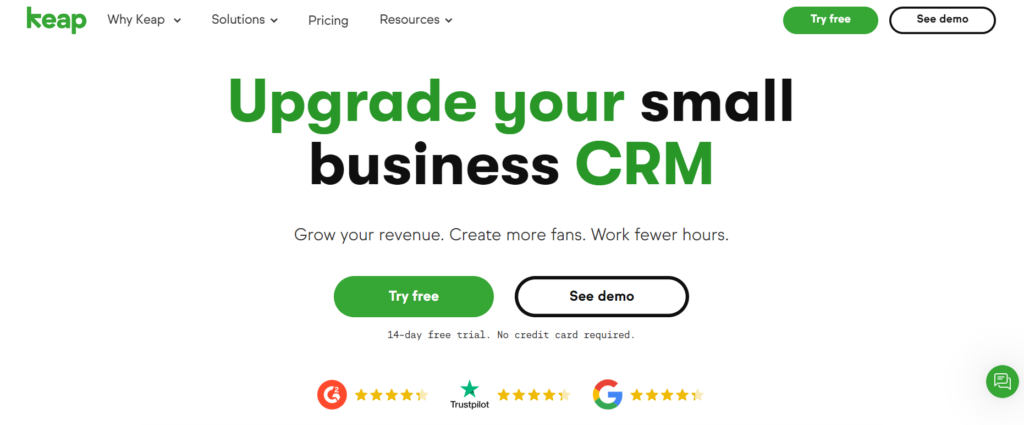
Keap, providing a unified platform for sales and marketing automation, stands out for its comprehensive approach.
Beneficial for businesses aiming for an all-encompassing solution, Keap offers scalability with various pricing plans.
Its transparent pricing structures, trial options, and flexibility make it accessible to businesses of different sizes, ensuring a cohesive strategy for customer engagement through effective sales cadences.
Features
- Keap offers features such as contact management, campaign automation, and e-commerce integration.
- Its unified platform integrates sales cadences into broader marketing and CRM strategies, providing a comprehensive approach to automation.
Why this is good for your business?
- Keap is beneficial for businesses seeking an all-encompassing solution for sales and marketing automation.
- Its unified approach ensures a cohesive strategy for customer engagement, making it suitable for businesses of different sizes.
How to measure the result of sales cadence?

1. Conversion rates
Analyzing conversion rates in sales cadences is crucial to understanding the effectiveness of the outreach strategy.
By tracking the percentage of leads that successfully transition through the sales process, businesses gain insights into the impact of their cadence on actual conversions.
This metric is essential for identifying successful engagement points and refining the cadence for optimal outcomes.
2. Response rates
Measuring response rates is a key aspect of evaluating how well a sales cadence resonates with prospects.
High response rates indicate that the cadence is capturing attention and fostering engagement.
Low response rates may signal the need for adjustments in messaging or timing, highlighting areas for improvement in the sales outreach strategy.
3. Sales cycle length
The duration it takes for leads to progress through the entire sales cadence and convert into customers is a critical metric.
A shorter sales cycle often signifies an efficient and compelling cadence strategy.
Analyzing sales cycle length helps businesses identify bottlenecks, streamline processes, and refine the cadence to accelerate conversions.
4. Deal velocity
Assessing the speed at which deals move through different stages of the sales cadence provides insights into the efficiency of the outreach strategy.
Faster deal velocity suggests that the cadence is resonating well with prospects, resulting in swift progression.
This metric is essential for gauging the overall effectiveness of the sales cadence in driving conversions.
5. Customer retention & satisfaction
Beyond conversion, evaluating customer retention and satisfaction rates among those acquired through the sales cadence is crucial.
A successful cadence not only converts leads but also contributes to long-term customer relationships.
High retention and satisfaction rates indicate that the cadence is not just effective in acquiring customers but also in fostering loyalty and positive experiences.
6. Feedback from sales team
Gathering feedback from the sales team provides qualitative insights into the day-to-day interactions and challenges faced during the sales cadence.
The frontline experience of the sales team is invaluable in understanding how well the cadence aligns with prospect expectations.
This feedback loop is essential for continuous improvement and refining the cadence based on real-world experiences.
Measuring these aspects in a sales cadence ensures a comprehensive evaluation of its impact and effectiveness.
These metrics, whether related to conversion rates, response rates, sales cycle length, deal velocity, customer retention, or feedback from the sales team, contribute to a data-driven approach for optimizing and fine-tuning the best sales cadence for sustained success in outbound sales efforts.
Conclusion
In the sales world, making a good sales cadence is super important. It’s like making sure your chat with customers is just right.
The six tricks discussed here give you a good plan to make your sales cadence special.
Adding personal touches, using different ways to talk to customers, and keeping track of how things are going can make your sales outreach even better.
As things change in sales, these tricks will help you keep up and ensure you’re doing a great job talking to customers and making your sales successful.
